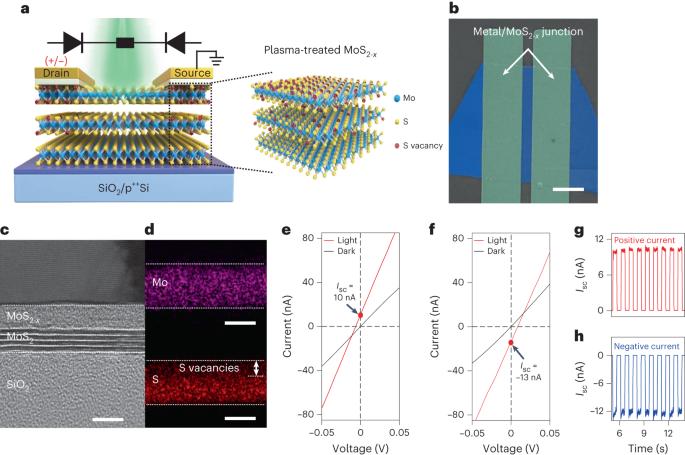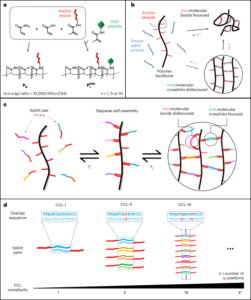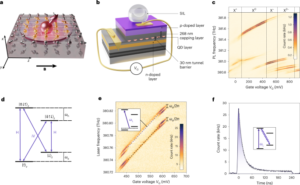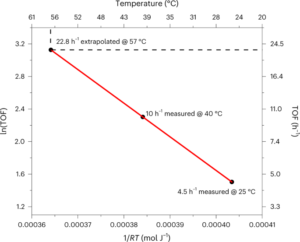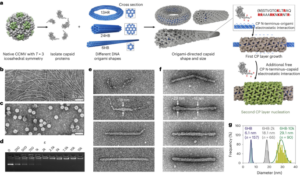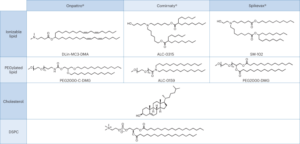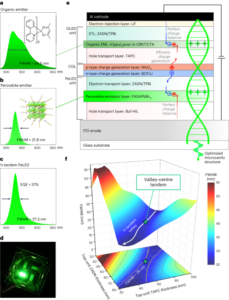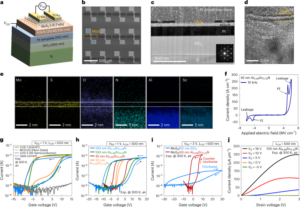
Sze, V., Chen, Y.-H., Emer, J., Suleiman, A. & Zhang, Z. Hardware for machine learning: challenges and opportunities. In 2017 IEEE Custom Integrated Circuits Conference (CICC) 179–186 (IEEE, 2017).
Zhou, F. C. & Chai, Y. Near-sensor and in-sensor computing. Nat. Electron. 3, 664–671 (2020).
Gollisch, T. & Meister, M. Even smarter than scientists believed: neural computations in circuits of the retina. Neuron 65, 150–164 (2010).
Kyuma, K. et al. Artificial retinas—fast, versatile image processors. Nature 372, 197–198 (1994).
Kolb, H. How the retina works—much of the construction of an image takes place in the retina itself through the use of specialized neural circuits. Am. Scientist 91, 28–35 (2003).
Funatsu, E. et al. An artificial retina chip with current-mode focal plane image processing functions. IEEE Trans. Electron Devices 44, 1777–1782 (1997).
Nitta, Y., Ohta, J., Tai, S. & Kyuma, K. Variable-sensitivity photodetector that uses a metal-semiconductor-metal structure for optical neural networks. Opt. Lett. 16, 611–613 (1991).
Jang, H. et al. In-sensor optoelectronic computing using electrostatically doped silicon. Nat. Electron. 5, 519–525 (2022).
Mennel, L. et al. Ultrafast machine vision with 2D material neural network image sensors. Nature 579, 62–66 (2020).
Chen, S., Lou, Z., Chen, D. & Shen, G. Z. An artificial flexible visual memory system based on an UV-motivated memristor. Adv. Mater. 30, 1705400 (2018).
Cui, B. Y. et al. Ferroelectric photosensor network: an advanced hardware solution to real-time machine vision. Nat. Commun. 13, 1707 (2022).
Sun, L. F. et al. In-sensor reservoir computing for language learning via two-dimensional memristors. Sci. Adv. 7, eabg1455 (2021).
Zhou, F. C. et al. Optoelectronic resistive random access memory for neuromorphic vision sensors. Nat. Nanotechnol. 14, 776–782 (2019).
Ahmed, T. et al. Optically stimulated artificial synapse based on layered black phosphorus. Small 15, 1900966 (2019).
Fu, X. et al. Graphene/MoS2−xOx/graphene photomemristor with tunable non-volatile responsivities for neuromorphic vision processing. Light.: Sci. Appl. 12, 39 (2023).
Lee, S. H., Peng, R. M., Wu, C. M. & Li, M. Programmable black phosphorus image sensor for broadband optoelectronic edge computing. Nat. Commun. 13, 1485 (2022).
Liao, F. Y. et al. Bioinspired in-sensor visual adaptation for accurate perception. Nat. Electron. 5, 84–91 (2022).
Liu, K. Q. et al. An optoelectronic synapse based on α-In2Se3 with controllable temporal dynamics for multimode and multiscale reservoir computing. Nat. Electron. 5, 761–773 (2022).
Pi, L. J. et al. Broadband convolutional processing using band-alignment-tunable heterostructures. Nat. Electron. 5, 248–254 (2022).
Seo, S. H. et al. Artificial optic-neural synapse for colored and color-mixed pattern recognition. Nat. Commun. 9, 5106 (2018).
Wang, C.-Y. et al. Gate-tunable van der Waals heterostructure for reconfigurable neural network vision sensor. Sci. Adv. 6, eaba6173 (2020).
Yu, J. R. et al. Bioinspired mechano-photonic artificial synapse based on graphene/MoS2 heterostructure. Sci. Adv. 7, eabd9117 (2021).
Zhang, Z. H. et al. All-in-one two-dimensional retinomorphic hardware device for motion detection and recognition. Nat. Nanotechnol. 17, 27–32 (2022).
Lien, D.-H. et al. Engineering light outcoupling in 2D materials. Nano Lett. 15, 1356–1361 (2015).
Wang, Q. H., Kalantar-Zadeh, K., Kis, A., Coleman, J. N. & Strano, M. S. Electronics and optoelectronics of two-dimensional transition metal dichalcogenides. Nat. Nanotechnol. 7, 699–712 (2012).
Shim, J. et al. Controlled crack propagation for atomic precision handling of wafer-scale two-dimensional materials. Science 362, 665–670 (2018).
Khan, M. A. et al. The non-volatile electrostatic doping effect in MoTe2 field-effect transistors controlled by hexagonal boron nitride and a metal gate. Sci. Rep. 12, 12085 (2022).
Wang, M. et al. Robust memristors based on layered two-dimensional materials. Nat. Electron. 1, 130–136 (2018).
Zhu, X. J., Li, D., Liang, X. & Lu, W. D. Ionic modulation and ionic coupling effects in MoS2 devices for neuromorphic computing. Nat. Mater. 18, 141–148 (2019).
Lee, H. S. et al. MoS2 nanosheets for top‐gate nonvolatile memory transistor channel. Small 8, 3111–3115 (2012).
Chen, H. W. et al. Logic gates based on neuristors made from two-dimensional materials. Nat. Electron. 4, 399–404 (2021).
Liu, W. et al. Graphene charge-injection photodetectors. Nat. Electron. 5, 281–288 (2022).
Tong, L. et al. 2D materials-based homogeneous transistor-memory architecture for neuromorphic hardware. Science 373, 1353–1358 (2021).
Wang, Y. et al. An in-memory computing architecture based on two-dimensional semiconductors for multiply-accumulate operations. Nat. Commun. 12, 3347 (2021).
Miao, J. S. et al. Heterojunction tunnel triodes based on two-dimensional metal selenide and three-dimensional silicon. Nat. Electron. 5, 744–751 (2022).
Choi, C. S. et al. Human eye-inspired soft optoelectronic device using high-density MoS2-graphene curved image sensor array. Nat. Commun. 8, 1664 (2017).
Cao, R. R. et al. Compact artificial neuron based on anti-ferroelectric transistor. Nat. Commun. 13, 7018 (2022).
Kim, S. H. et al. Effects of plasma treatment on surface properties of ultrathin layered MoS2. 2D Mater. 3, 035002 (2016).
Kang, N., Paudel, H. P., Leuenberger, M. N., Tetard, L. & Khondaker, S. I. Photoluminescence quenching in single-layer MoS2 via oxygen plasma treatment. J. Phys. Chem. C 118, 21258–21263 (2014).
Duy, L., Rawal, T. B. & Rahman, T. S. Single-layer MoS2 with sulfur vacancies: structure and catalytic application. J. Phys. Chem. C 118, 5346–5351 (2014).
Komsa, H.-P., Kurasch, S., Lehtinen, O., Kaiser, U. & Krasheninnikov, A. V. From point to extended defects in two-dimensional MoS2: evolution of atomic structure under electron irradiation. Phys. Rev. B 88, 035301 (2013).
Li, D. et al. MoS2 memristors exhibiting variable switching characteristics toward biorealistic synaptic emulation. ACS Nano 12, 9240–9252 (2018).
Sangwan, V. K. et al. Multi-terminal memtransistors from polycrystalline monolayer molybdenum disulfide. Nature 554, 500–504 (2018).
Chen, Q. et al. Ultralong 1D vacancy channels for rapid atomic migration during 2D void formation in monolayer MoS2. ACS Nano 12, 7721–7730 (2018).
Zhou, X. Y., Koltun, V. & Krähenbühl, P. Tracking objects as points. In 16th European Conference on Computer Vision (ECCV) 474–490 (Springer, 2020).
Redmon, J., Divvala, S., Girshick, R. & Farhadi, A. You only look once: unified, real-time object detection. In 2016 IEEE Conference on Computer Vision and Pattern Recognition (CVPR) 779–788 (IEEE, 2016).
Ren, S., He, K., Girshick, R. & Sun, J. Faster R-CNN: towards real-time object detection with region proposal networks. IEEE Trans. Pattern Anal. Mach. Intell. 39, 1137–1149 (2017).
Ielmini, D. & Wong, H. S. P. In-memory computing with resistive switching devices. Nat. Electron. 1, 333–343 (2018).
- SEO Powered Content & PR Distribution. Get Amplified Today.
- PlatoData.Network Vertical Generative Ai. Empower Yourself. Access Here.
- PlatoAiStream. Web3 Intelligence. Knowledge Amplified. Access Here.
- PlatoESG. Automotive / EVs, Carbon, CleanTech, Energy, Environment, Solar, Waste Management. Access Here.
- BlockOffsets. Modernizing Environmental Offset Ownership. Access Here.
- Source: https://www.nature.com/articles/s41565-023-01446-8
- ][p
- 1
- 10
- 11
- 12
- 13
- 14
- 15%
- 16
- 17
- 19
- 1994
- 20
- 2012
- 2013
- 2014
- 2015
- 2016
- 2017
- 2018
- 2019
- 2020
- 2021
- 2022
- 2023
- 22
- 23
- 24
- 25
- 26
- 27
- 28
- 2D
- 2D materials
- 30
- 31
- 32
- 33
- 36
- 39
- 40
- 46
- 7
- 8
- 9
- a
- access
- accurate
- adaptation
- advanced
- AL
- all-in-one
- an
- and
- Application
- architecture
- Array
- article
- artificial
- AS
- b
- based
- believed
- Black
- broadband
- by
- challenges
- Channel
- channels
- characteristics
- chen
- chip
- CICC
- click
- computations
- computer
- Computer Vision
- computing
- Conference
- construction
- controlled
- crack
- CVPR
- Detection
- device
- Devices
- during
- dynamics
- e
- E&T
- Edge
- edge computing
- effect
- effects
- Electronics
- Engineering
- Ether (ETH)
- European
- Even
- evolution
- Exhibiting
- faster
- flexible
- For
- formation
- from
- functions
- Gates
- Graphene
- Handling
- Hardware
- hardware device
- he
- How
- http
- HTTPS
- human
- i
- IEEE
- image
- in
- integrated
- Ionic
- itself
- language
- layered
- learning
- li
- light
- LINK
- logic
- Look
- machine
- machine learning
- machine vision
- made
- material
- materials
- Memory
- metal
- migration
- motion
- nanotechnology
- Nature
- network
- networks
- Neural
- neural network
- neural networks
- object
- Object Detection
- objects
- of
- on
- once
- only
- Operations
- opportunities
- Oxygen
- Pattern
- perception
- Place
- Plasma
- plato
- Plato Data Intelligence
- PlatoData
- Point
- points
- Precision
- processing
- processors
- propagation
- properties
- proposal
- random
- rapid
- real-time
- recognition
- region
- Retina
- robust
- s
- SCI
- scientists
- Semiconductors
- sensors
- Silicon
- smarter
- Soft
- solution
- specialized
- structure
- Sun
- Surface
- Synapse
- system
- T
- takes
- than
- that
- The
- three-dimensional
- Through
- to
- toward
- towards
- Tracking
- transition
- treatment
- tunnel
- under
- unified
- use
- uses
- using
- versatile
- via
- vision
- W
- with
- wong
- wu
- X
- you
- zephyrnet

